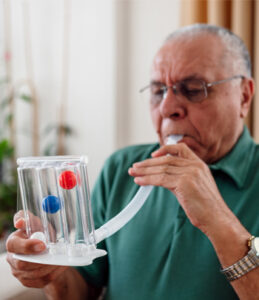
COPD in Veterans: What You Need to Know
Chronic obstructive pulmonary disease (COPD) refers to a group of diseases that cause airflow blockage and breathing-related problems. It includes emphysema and chronic bronchitis. About 16 million Americans have been diagnosed with this disease and millions more suffer from it but have not been diagnosed. What do you need to know about COPD? This article walks you through what causes it, what symptoms to look for, and what treatment options and resources are available to help.
What Causes COPD?
COPD makes it difficult to breathe and can limit your ability to work or do simple daily tasks. It can also make it more likely for you to get severely ill from COVID-19. So what causes COPD? There is a range of factors that can cause COPD, but here are some of the most common:
- Tobacco smoke
- Exposure to air pollutants in the home and workplace
- Genetic factors
- Respiratory infections
What Are the Signs or Symptoms of COPD?
People with COPD often have symptoms related to breathing trouble. These may include:
- Frequent coughing or wheezing
- Excess phlegm or mucus
- Shortness of breath
- Trouble taking a deep breath
In addition, compared with other adults, people with COPD:
- Are more likely to have difficulty walking or climbing stairs
- May be unable to work
- May need special equipment like a portable oxygen tank
- Feel unable to engage in activities like going out to eat, getting together with friends and more
- Have more emergency room visits
- Have other chronic diseases like arthritis, diabetes, asthma and more
- Struggle with mental and emotional health conditions such as depression
What Steps Do I Take If I’m Concerned About My Health?
Early detection of COPD may change its course and progress, so be sure to talk to your health care provider about getting tested.
There are several things you can do if you are concerned about COPD or breathing-related issues. If you are a smoker, the first thing you can do is quit. No matter how old you are, how long you’ve smoked or why you started, there are proven treatments available to help. Check out Make a Plan You Can Stick to: Quit Smoking Today to learn more about getting the support you need. It’s also important to avoid tobacco smoke and other air pollutants as best you can. This may mean taking precautions such as wearing a face mask to reduce your exposure.
Early detection of COPD may change its course and progress so be sure to talk to your health care provider about a simple test, called spirometry, which can be used to measure your lung function and detect COPD. From there, you and your health care provider can do a careful and thorough evaluation to see if you need to begin a treatment plan.
What Treatment Options Are Available for COPD?
Although there is no cure for COPD, it can be treated. With treatment, you can alleviate symptoms, decrease the frequency or severity of exacerbations and increase your exercise tolerance. Treatment options can be discussed with your health care provider to ensure that whatever you decide is tailored to your health and wellness needs. Treatment may include:
- A plan to quit smoking: Quitting has the greatest impact on slowing COPD progression.
- Pulmonary rehabilitation: Talk to your health care provider about a program that can teach you COPD management strategies to improve your quality of life.
- Medication: You can take medications to help with symptoms such as coughing and wheezing.
- Vaccines: Stay up to date on your vaccines. Lung infections can cause serious problems for people with COPD, so flu and pneumococcal vaccines are especially important. Check out Immunizations: Get the Information You Need to Stay Healthy to learn which vaccines are recommended for you.
- Supplemental oxygen: If your oxygen levels are too low, you may need it.
- Proper nutrition and exercise: If you take care of your overall health and wellness you can help improve the quality of your life and reduce COPD exacerbations.
What Resources Are Available to Me as a Veteran?
The rates of COPD are higher in certain populations, including women, people over 65 years of age, American Indians and Alaska Natives, current or former smokers, as well as Veterans. Because of this additional risk, it’s important to talk to your health care provider, ask to be tested and consider any aspect of your service that may have led to environmental or occupational exposure.
Exposure to toxic air can cause COPD so if you were exposed to particulate matter, burn pits, sandstorms or Agent Orange during your service, talk to your health care provider, check on the Department of Veterans Affairs (VA) site or contact your local VA Environmental Health Coordinator. You can learn more about COPD as a presumptive condition as well as what benefits you may qualify for on VA’s Airborne Hazards and Burn Pit Exposures page.
You deserve to live your fullest life. Between access to high-quality treatment and resources through your VA health care as well as some proactive lifestyle choices, you can reduce your risk of COPD and better manage the symptoms related to it.







